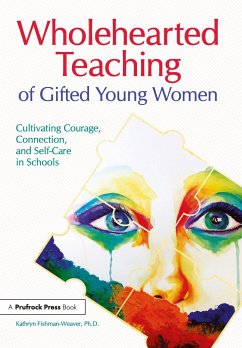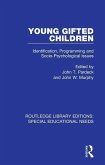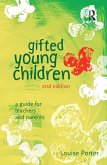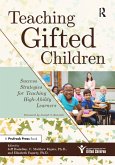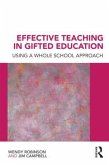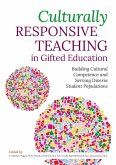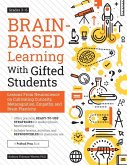Kathryn Fishman-Weaver
Wholehearted Teaching of Gifted Young Women
Cultivating Courage, Connection, and Self-Care in Schools
Kathryn Fishman-Weaver
Wholehearted Teaching of Gifted Young Women
Cultivating Courage, Connection, and Self-Care in Schools
- Broschiertes Buch
- Merkliste
- Auf die Merkliste
- Bewerten Bewerten
- Teilen
- Produkt teilen
- Produkterinnerung
- Produkterinnerung
Wholehearted Teaching of Gifted Young Women explores the important role school communities play in supporting the social and emotional needs of high-achieving young women. Using a youth participatory action research model, this project follows 20 student researchers from high school through college. This longitudinal study leads to ¿ÄúWholehearted Teaching,¿Äù a new framework for cultivating courage, connection, and self-care in schools. Framed with personal stories and filled with practical suggestions, this book offers strategies for teachers, counselors, parents, and high-achieving young…mehr
Andere Kunden interessierten sich auch für
![Young Gifted Children Young Gifted Children]() Young Gifted Children60,99 €
Young Gifted Children60,99 €![Gifted Young Children Gifted Young Children]() Louise PorterGifted Young Children46,99 €
Louise PorterGifted Young Children46,99 €![Teaching Gifted Children Teaching Gifted Children]() Jeff DanielianTeaching Gifted Children58,99 €
Jeff DanielianTeaching Gifted Children58,99 €![Effective Teaching in Gifted Education Effective Teaching in Gifted Education]() Wendy RobinsonEffective Teaching in Gifted Education69,99 €
Wendy RobinsonEffective Teaching in Gifted Education69,99 €![Culturally Responsive Teaching in Gifted Education Culturally Responsive Teaching in Gifted Education]() Culturally Responsive Teaching in Gifted Education51,99 €
Culturally Responsive Teaching in Gifted Education51,99 €![YES to Treshia A Young Gifted and Talented Girl YES to Treshia A Young Gifted and Talented Girl]() Stephanie MastrangeloYES to Treshia A Young Gifted and Talented Girl30,99 €
Stephanie MastrangeloYES to Treshia A Young Gifted and Talented Girl30,99 €![Brain-Based Learning With Gifted Students Brain-Based Learning With Gifted Students]() Kathryn Fishman-WeaverBrain-Based Learning With Gifted Students42,99 €
Kathryn Fishman-WeaverBrain-Based Learning With Gifted Students42,99 €-
-
-
Wholehearted Teaching of Gifted Young Women explores the important role school communities play in supporting the social and emotional needs of high-achieving young women. Using a youth participatory action research model, this project follows 20 student researchers from high school through college. This longitudinal study leads to ¿ÄúWholehearted Teaching,¿Äù a new framework for cultivating courage, connection, and self-care in schools. Framed with personal stories and filled with practical suggestions, this book offers strategies for teachers, counselors, parents, and high-achieving young women as they navigate the precipice of youth and everything after.
Hinweis: Dieser Artikel kann nur an eine deutsche Lieferadresse ausgeliefert werden.
Hinweis: Dieser Artikel kann nur an eine deutsche Lieferadresse ausgeliefert werden.
Produktdetails
- Produktdetails
- Verlag: Routledge
- Seitenzahl: 214
- Erscheinungstermin: 1. Dezember 2018
- Englisch
- Abmessung: 254mm x 178mm x 12mm
- Gewicht: 413g
- ISBN-13: 9781618218186
- ISBN-10: 1618218182
- Artikelnr.: 52208998
- Herstellerkennzeichnung
- Libri GmbH
- Europaallee 1
- 36244 Bad Hersfeld
- gpsr@libri.de
- Verlag: Routledge
- Seitenzahl: 214
- Erscheinungstermin: 1. Dezember 2018
- Englisch
- Abmessung: 254mm x 178mm x 12mm
- Gewicht: 413g
- ISBN-13: 9781618218186
- ISBN-10: 1618218182
- Artikelnr.: 52208998
- Herstellerkennzeichnung
- Libri GmbH
- Europaallee 1
- 36244 Bad Hersfeld
- gpsr@libri.de
Kathryn Fishman-Weaver, Ph.D., serves as the Director of Academic Affairs for Mizzou K-12. As the principal of the global middle and high school programs, she works with students and teachers around the world. Prior to the principalship, Dr. Fishman-Weaver taught in public schools in Oakland, CA, and Columbia, MO. She has taught special education, gifted education, English language arts, and teacher preparation. Dr. Fishman-Weaver writes and presents frequently on student support, teacher leadership, and gender and education. She loves the written word, a good nap, and impromptu family dance parties in her kitchen. You can follow her work on educational leadership at http://wholeheartedschoolleadership.com.
List of Figures Acknowledgments Part I: A Case for Affective Education Chapter 1: The Masked Affective Crisis
What Is Your Central Story?
School Context Discovering the Masked Affective Crisis Why Women? Giftedness: A Loaded Label Academic Achievement Crisis as a Call to Action Wholehearted Living Vulnerability and Storytelling Self-Compassion and Perfectionism Teacher as Researcher Telling Our Story A Note About Pronouns Chapter 2: The Precipice The Precipice: Navigating the Space Between High School and College Overachievement Culture Affective Development: A Brief Overview Gifted Education and Affective Development Intersectionality and Coming-of-Age Theoretical Framework: Feminism Youth Participatory Action Research Part II: Cultivating Courage, Connection, and Self-Care in Schools Chapter 3: Courage Naming Courage Courage Is Contextualized by Power The Importance of Safe Space in Schools Courage Is Emotionally Charged Precipice and the Possibility for Courage The Ripple Effect of Practicing Courage Chapter 4: Connection Belonging Relatedness Closeness The Momentum of Connection High Stress, High Schools, and (Dis)Connection Critical Listening, Compassion, and Communication Connection Is Complicated Mothers: Mentors and Critics Connectedness as a Catalyst for Action An Exercise in Hope Chapter 5: Self-Care Self-Care Stories From Barnwood High School Self-Care Through Courage and Connection Positive Self-Image + Self-Efficacy = Preconditions for Self-Care Rejection Making College Decisions Self-Doubt
s Continued Grip Confronting Self-Doubt Embodying Self-Care Physical Strength Weight and Balance Managing Self-Care: Five Student Examples Part III: Wholehearted Teaching Chapter 6: A Framework for Wholehearted Teaching Limited Strong What Does It Mean to Feel Strong? Guarded Vulnerable Privilege, Power, and Vulnerable Stories Strength + Vulnerability = Courage Low Achievement High Achievement Self-Harm Self-Care Self-Care + High Achievement = Healthy Striving Vulnerability + High Achievement = Growth Mindset Self-Care + Strength = Wellness Connection: The Multiplier Across Wholehearted Teaching A Multiplicity of
Right
Answers Chapter 7: Implementing Wholehearted Teaching Practice Courage, Connection, and Self-Care Be an Active Listener Encourage Student Leadership Students as Researchers Service Learning Increase Opportunities for Play and Laughter Leverage Community Expertise Schedule Peer-Group Meetings Integrate Self-Care Into Your Classroom Environment Make Storytelling Part of Your School Community Honor Nuance Continued Support During the College Transition A Message for Educators Chapter 8: Coming Home Healing Keeping My Office Door Open Humanizing Exiting The Expansive Properties of Home References Methodology Appendix About the Author
What Is Your Central Story?
School Context Discovering the Masked Affective Crisis Why Women? Giftedness: A Loaded Label Academic Achievement Crisis as a Call to Action Wholehearted Living Vulnerability and Storytelling Self-Compassion and Perfectionism Teacher as Researcher Telling Our Story A Note About Pronouns Chapter 2: The Precipice The Precipice: Navigating the Space Between High School and College Overachievement Culture Affective Development: A Brief Overview Gifted Education and Affective Development Intersectionality and Coming-of-Age Theoretical Framework: Feminism Youth Participatory Action Research Part II: Cultivating Courage, Connection, and Self-Care in Schools Chapter 3: Courage Naming Courage Courage Is Contextualized by Power The Importance of Safe Space in Schools Courage Is Emotionally Charged Precipice and the Possibility for Courage The Ripple Effect of Practicing Courage Chapter 4: Connection Belonging Relatedness Closeness The Momentum of Connection High Stress, High Schools, and (Dis)Connection Critical Listening, Compassion, and Communication Connection Is Complicated Mothers: Mentors and Critics Connectedness as a Catalyst for Action An Exercise in Hope Chapter 5: Self-Care Self-Care Stories From Barnwood High School Self-Care Through Courage and Connection Positive Self-Image + Self-Efficacy = Preconditions for Self-Care Rejection Making College Decisions Self-Doubt
s Continued Grip Confronting Self-Doubt Embodying Self-Care Physical Strength Weight and Balance Managing Self-Care: Five Student Examples Part III: Wholehearted Teaching Chapter 6: A Framework for Wholehearted Teaching Limited Strong What Does It Mean to Feel Strong? Guarded Vulnerable Privilege, Power, and Vulnerable Stories Strength + Vulnerability = Courage Low Achievement High Achievement Self-Harm Self-Care Self-Care + High Achievement = Healthy Striving Vulnerability + High Achievement = Growth Mindset Self-Care + Strength = Wellness Connection: The Multiplier Across Wholehearted Teaching A Multiplicity of
Right
Answers Chapter 7: Implementing Wholehearted Teaching Practice Courage, Connection, and Self-Care Be an Active Listener Encourage Student Leadership Students as Researchers Service Learning Increase Opportunities for Play and Laughter Leverage Community Expertise Schedule Peer-Group Meetings Integrate Self-Care Into Your Classroom Environment Make Storytelling Part of Your School Community Honor Nuance Continued Support During the College Transition A Message for Educators Chapter 8: Coming Home Healing Keeping My Office Door Open Humanizing Exiting The Expansive Properties of Home References Methodology Appendix About the Author
List of Figures Acknowledgments Part I: A Case for Affective Education Chapter 1: The Masked Affective Crisis
What Is Your Central Story?
School Context Discovering the Masked Affective Crisis Why Women? Giftedness: A Loaded Label Academic Achievement Crisis as a Call to Action Wholehearted Living Vulnerability and Storytelling Self-Compassion and Perfectionism Teacher as Researcher Telling Our Story A Note About Pronouns Chapter 2: The Precipice The Precipice: Navigating the Space Between High School and College Overachievement Culture Affective Development: A Brief Overview Gifted Education and Affective Development Intersectionality and Coming-of-Age Theoretical Framework: Feminism Youth Participatory Action Research Part II: Cultivating Courage, Connection, and Self-Care in Schools Chapter 3: Courage Naming Courage Courage Is Contextualized by Power The Importance of Safe Space in Schools Courage Is Emotionally Charged Precipice and the Possibility for Courage The Ripple Effect of Practicing Courage Chapter 4: Connection Belonging Relatedness Closeness The Momentum of Connection High Stress, High Schools, and (Dis)Connection Critical Listening, Compassion, and Communication Connection Is Complicated Mothers: Mentors and Critics Connectedness as a Catalyst for Action An Exercise in Hope Chapter 5: Self-Care Self-Care Stories From Barnwood High School Self-Care Through Courage and Connection Positive Self-Image + Self-Efficacy = Preconditions for Self-Care Rejection Making College Decisions Self-Doubt
s Continued Grip Confronting Self-Doubt Embodying Self-Care Physical Strength Weight and Balance Managing Self-Care: Five Student Examples Part III: Wholehearted Teaching Chapter 6: A Framework for Wholehearted Teaching Limited Strong What Does It Mean to Feel Strong? Guarded Vulnerable Privilege, Power, and Vulnerable Stories Strength + Vulnerability = Courage Low Achievement High Achievement Self-Harm Self-Care Self-Care + High Achievement = Healthy Striving Vulnerability + High Achievement = Growth Mindset Self-Care + Strength = Wellness Connection: The Multiplier Across Wholehearted Teaching A Multiplicity of
Right
Answers Chapter 7: Implementing Wholehearted Teaching Practice Courage, Connection, and Self-Care Be an Active Listener Encourage Student Leadership Students as Researchers Service Learning Increase Opportunities for Play and Laughter Leverage Community Expertise Schedule Peer-Group Meetings Integrate Self-Care Into Your Classroom Environment Make Storytelling Part of Your School Community Honor Nuance Continued Support During the College Transition A Message for Educators Chapter 8: Coming Home Healing Keeping My Office Door Open Humanizing Exiting The Expansive Properties of Home References Methodology Appendix About the Author
What Is Your Central Story?
School Context Discovering the Masked Affective Crisis Why Women? Giftedness: A Loaded Label Academic Achievement Crisis as a Call to Action Wholehearted Living Vulnerability and Storytelling Self-Compassion and Perfectionism Teacher as Researcher Telling Our Story A Note About Pronouns Chapter 2: The Precipice The Precipice: Navigating the Space Between High School and College Overachievement Culture Affective Development: A Brief Overview Gifted Education and Affective Development Intersectionality and Coming-of-Age Theoretical Framework: Feminism Youth Participatory Action Research Part II: Cultivating Courage, Connection, and Self-Care in Schools Chapter 3: Courage Naming Courage Courage Is Contextualized by Power The Importance of Safe Space in Schools Courage Is Emotionally Charged Precipice and the Possibility for Courage The Ripple Effect of Practicing Courage Chapter 4: Connection Belonging Relatedness Closeness The Momentum of Connection High Stress, High Schools, and (Dis)Connection Critical Listening, Compassion, and Communication Connection Is Complicated Mothers: Mentors and Critics Connectedness as a Catalyst for Action An Exercise in Hope Chapter 5: Self-Care Self-Care Stories From Barnwood High School Self-Care Through Courage and Connection Positive Self-Image + Self-Efficacy = Preconditions for Self-Care Rejection Making College Decisions Self-Doubt
s Continued Grip Confronting Self-Doubt Embodying Self-Care Physical Strength Weight and Balance Managing Self-Care: Five Student Examples Part III: Wholehearted Teaching Chapter 6: A Framework for Wholehearted Teaching Limited Strong What Does It Mean to Feel Strong? Guarded Vulnerable Privilege, Power, and Vulnerable Stories Strength + Vulnerability = Courage Low Achievement High Achievement Self-Harm Self-Care Self-Care + High Achievement = Healthy Striving Vulnerability + High Achievement = Growth Mindset Self-Care + Strength = Wellness Connection: The Multiplier Across Wholehearted Teaching A Multiplicity of
Right
Answers Chapter 7: Implementing Wholehearted Teaching Practice Courage, Connection, and Self-Care Be an Active Listener Encourage Student Leadership Students as Researchers Service Learning Increase Opportunities for Play and Laughter Leverage Community Expertise Schedule Peer-Group Meetings Integrate Self-Care Into Your Classroom Environment Make Storytelling Part of Your School Community Honor Nuance Continued Support During the College Transition A Message for Educators Chapter 8: Coming Home Healing Keeping My Office Door Open Humanizing Exiting The Expansive Properties of Home References Methodology Appendix About the Author

